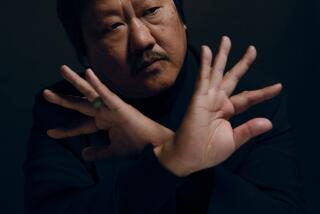drawing on the wind
- Share via
With “Bambi” and “The Wild Bunch” far behind him, 87-year-old Tyrus Wong has more time to spend at the beach. His medium there is different from the pre-production paintings that established him as one of the film world’s most respected illustrators. But the small, spry man still gets to show off his artistic legerdemain each time he leaves his Sunland-area home to go fly a kite.
Wong, who was born in a small village near Canton, China, came to Los Angeles as a boy and grew up near downtown. While attending the Otis Art Institute, he met Marc Davis, the future animator of Cinderella, Tinker Bell and Cruella DeVil.
During the late ‘30s, the two men spent nearly four years painting and drawing preliminary art to inspire the animators and story artists working on Walt Disney’s “Bambi.”
“The script would say, ‘Early morning: the deer goes out onto the meadow.’ I would try to create the atmosphere of that meadow, the fog on it and so forth . . . mood sketches,” Wong says. “My painting has always been very poetic--that’s the Chinese influence. In Chinese art, the poet is a painter and the painter is a poet. The object isn’t to reproduce photographic reality, as it is in Western painting, but to capture a feeling.”
The blend that Wong and Davis brought to the film created its delicately naturalistic look. “An oak leaf is an oak leaf,” says Davis, “but it’s a different oak leaf when Ty paints it: You perceive it differently and appreciate the way he evokes all oak leaves.”
Disney artist Paul Felix, whose work includes pre-production drawings for “Mulan” and “Tarzan,” says that Wong’s Bambi paintings “inspired me to try to tell more with less. They’ve been the point of departure in discussions of visual styling on all the films I’ve worked on.”
After “Bambi,” Wong moved to Warner Bros., where his illustrations suggested how scenes or settings might appear in such diverse films as “Harper,” “The Wild Bunch” and “Rebel Without a Cause.” When things were slow, the studio would loan him to Republic Pictures. “I did a lot of John Wayne movies there,” Wong says.
Wong became interested in kite making in the late ‘60s, when he had trouble finding friends he was supposed to meet one afternoon at a crowded beach. Before the group’s next picnic, he turned a windsock into a brightly colored flying tiger, gave it to his pals and asked them to send it aloft on a 10-foot string. He used the flapping creation as a beacon to guide him through the throngs.
Wong’s next kite was swallow-shaped and decorated with oil paint. That made it too heavy to fly. So he experimented with materials, finally settling on a combination of acrylic paint, ripstop nylon, rattan and bamboo.
His first successful creation was a pair of swallows, a Chinese symbol for “double festivity,” which he later expanded into a flock of 25 realistically painted birds. The key to unusually shaped kites, Wong soon discovered, was balance. Although his centipede is more than 100 feet long, it seems to leap into the air at the slightest tug of its string. The feather-tipped ribs “are like the long pole a tightrope walker uses--same principle.” A kite as large and elaborate as the centipede may require a month or more to complete; he can create a single bird in a day.
Some of Wong’s creations echo the natural forms of goldfish, dragonflies and butterflies; others are fantasies. All undulate in the ocean breeze, laying brush strokes on his canvas of sky.
More to Read
Only good movies
Get the Indie Focus newsletter, Mark Olsen's weekly guide to the world of cinema.
You may occasionally receive promotional content from the Los Angeles Times.










